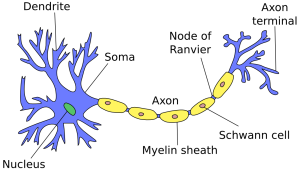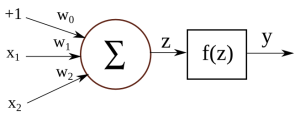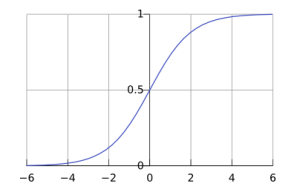NEURAL NETWORKS, PART 2: THE NEURON
NEURAL NETWORKS, PART 2: THE NEURON
A neuron is a very basic classifier. It takes a number of input signals (a feature vector) and outputs a single value (a prediction). A neuron is also a basic building block of neural networks, and by combining together many neurons we can build systems that are capable of learning very complicated patterns. This is part 2 of an introductory series on neural networks. If you haven’t done so yet, you might want to start by learning about the background to neural networks in part 1.
Neurons in artificial neural networks are inspired by biological neurons in nervous systems (shown below). A biological neuron has three main parts: the main body (also known as the soma), dendrites and an axon. There are often many dendrites attached to a neuron body, but only one axon, which can be up to a meter long. In most cases (although there are exceptions), the neuron receives input signals from dendrites, and then outputs its own signals through the axon. Axons in turn connect to the dendrites of other neurons, using special connections called synapses, forming complex neural networks.
 Figure 1: Biological neuron in a nervous system
Figure 1: Biological neuron in a nervous system
Below is an illustration of an artificial neuron, where the input is passed in from the left and the prediction comes out from the right. Each input position has a specific weight in the neuron, and they determine what output to give, given a specific input vector. For example, a neuron could be trained to detect cities. We can then take the vector for London from the previous section, give it as input to our neuron, and it will tell us it’s a city by outputting value 1. If we do the same for the word Tuesday, it will give a 0 instead, meaning that it’s not a city.
 Figure 2: Artificial neuron
Figure 2: Artificial neuron
You might notice that there’s a constant value of +1 as one of the input signals, and it has a separate weight w0. This is called a bias, and it allows the network to shift the activation function up or down. Biases are not strictly required for building neurons or neural networks, but they can be very important to the performance, depending on the types of feature values you are using.
Let’s say we have an input vector [1,x1,x2] and a weight vector [w0,w1,w2]. Internally, we first multiply the corresponding input values with their weights, and add them together:
z=(w0×1)+(w1×x1)+(w2×x2)
Then, we pass the sum through an activation function. In this case we will use the sigmoid function (also known as the logistic curve) as our activation function.
y=f(z)=f((w0×1)+(w1×x1)+(w2×x2))
where
f(t)=11+e−t
The sigmoid function takes any real value and maps it to a range between 0 and 1. When plotted, a sigmoid function looks like this:
 Figure 3: Sigmoid function
Figure 3: Sigmoid function
Using a sigmoid as our activation function has some benefits:
- Regardless of input, it will map everything to a range between 0 and 1. We don’t have to worry about output values exploding for unexpected input vectors.
- The function is non-linear, which allows us to learn more complicated non-linear relationships in our neural networks.
- It is differentiable, which comes in handy when we try to perform backpropagation to train our neural networks.
However, it is not required to use an activation function, and there exist many successful network architectures that don’t use one. We could also use a different activation, such as a hyperbolic tangent or a rectifier.
We have now looked at all the components of a neuron, but we’re not going to stop here. Richard Feynman once said “What I cannot create, I do not understand”, so let us create a working example of a neuron. Here is the complete code required to test a neuron with pre-trained weights:
|
1
2
3
4
5
6
7
8
9
10
11
12
13
14
15
16
17
18
19
20
21
22
23
24
25
26
27
28
29
30
31
32
33
34
35
36
37
38
39
40
41
42
43
44
45
46
47
48
49
50
51
52
53
54
55
56
57
|
public class SimpleNeuron { private double[] weights; public SimpleNeuron(double[] weights){ this.weights = weights; } public double classify(double[] input){ double value = 0.0; // Adding the bias value += weights[0] * 1.0; // Adding the rest of the weights for(int i = 0; i < input.length; i++) value += weights[i + 1] * input[i]; // Passing the value through the sigmoid activation function value = 1.0 / (1.0 + Math.exp(-1.0 * value)); return value; } public static void main(String[] args) { // Creating data structures to hold the data String[] names = new String[5]; double[][] vectors = new double[5][2]; // Inserting the data names[0] = "London"; vectors[0][0] = 0.86; vectors[0][1] = 0.09; names[1] = "Paris"; vectors[1][0] = 0.74; vectors[1][1] = 0.11; names[2] = "Tuesday"; vectors[2][0] = 0.15; vectors[2][1] = 0.77; names[3] = "Friday"; vectors[3][0] = 0.05; vectors[3][1] = 0.82; names[4] = "???"; vectors[4][0] = 0.59; vectors[4][1] = 0.19; // Initialising the weights double[] weights = {0.0, 100.0, -100.0}; SimpleNeuron neuron = new SimpleNeuron(weights); // Classifying each of the data points for(int i = 0; i < names.length; i++){ double prediction = neuron.classify(vectors[i]); System.out.println(names[i] + " : " + (int)prediction); } }} |
The classify() function is the interesting part in this code. It takes a feature vector as an argument and returns the prediction value y. For testing, we use the examples from the previous section and try to classify each of them. The output of running this code will be as follows:
|
1
2
3
4
5
|
London : 1Paris : 1Tuesday : 0Friday : 0??? : 1 |
As you can see, the neuron has successfully separated cities from days. It has also provided a label for the previously-unknown example – apparently the last data point should belong with cities as well.
For this code example, I manually chose and hard-coded weight values, so that it would provide a good classification. In later sections we will see how to have the system learn these values automatically, using some training data.
Now that we know about individual neurons, in the next section we’ll look at how to connect them together and form neural networks.
NEURAL NETWORKS, PART 2: THE NEURON的更多相关文章
- 【转】Artificial Neurons and Single-Layer Neural Networks
原文:written by Sebastian Raschka on March 14, 2015 中文版译文:伯乐在线 - atmanic 翻译,toolate 校稿 This article of ...
- [转]Neural Networks, Manifolds, and Topology
colah's blog Blog About Contact Neural Networks, Manifolds, and Topology Posted on April 6, 2014 top ...
- A Beginner's Guide To Understanding Convolutional Neural Networks(转)
A Beginner's Guide To Understanding Convolutional Neural Networks Introduction Convolutional neural ...
- [CS231n-CNN] Training Neural Networks Part 1 : activation functions, weight initialization, gradient flow, batch normalization | babysitting the learning process, hyperparameter optimization
课程主页:http://cs231n.stanford.edu/ Introduction to neural networks -Training Neural Network ________ ...
- Hacker's guide to Neural Networks
Hacker's guide to Neural Networks Hi there, I'm a CS PhD student at Stanford. I've worked on Deep Le ...
- ON THE EVOLUTION OF MACHINE LEARNING: FROM LINEAR MODELS TO NEURAL NETWORKS
ON THE EVOLUTION OF MACHINE LEARNING: FROM LINEAR MODELS TO NEURAL NETWORKS We recently interviewed ...
- Stanford机器学习---第五讲. 神经网络的学习 Neural Networks learning
原文 http://blog.csdn.net/abcjennifer/article/details/7758797 本栏目(Machine learning)包括单参数的线性回归.多参数的线性回归 ...
- 深度学习笔记(三 )Constitutional Neural Networks
一. 预备知识 包括 Linear Regression, Logistic Regression和 Multi-Layer Neural Network.参考 http://ufldl.stanfo ...
- 提高神经网络的学习方式Improving the way neural networks learn
When a golf player is first learning to play golf, they usually spend most of their time developing ...
随机推荐
- Context
Context,中文直译为“上下文”,SDK中对其说明如下: Interface to global information about an application environment. Thi ...
- Day05 - Python 常用模块
1. 模块简介 模块就是一个保存了 Python 代码的文件.模块能定义函数,类和变量.模块里也能包含可执行的代码. 模块也是 Python 对象,具有随机的名字属性用来绑定或引用. 下例是个简单的模 ...
- is_numeric漏洞分析
2014年,PHP中is_numeric函数十六进制绕过漏洞引发了一次安全问题 接下来,我们来分析一下这个漏洞的原理 函数介绍: is_numeric — 检测变量是否为数字或数字字符串. 函数原型: ...
- JavaScript 应用开发 #1:理解模型与集合
在 < Backbone 应用实例 > 这个课程里面,我们会一起用 JavaScript 做一个小应用,它可以管理任务列表,应用可以创建新任务,编辑还有删除任务等等.这个实例非常好的演示了 ...
- java 数组注意点
int[] array1 = new int[4]; int[] array2 = new int[6]; int[] array3 = new int[8]; array2 = array1; ar ...
- 关于try和finaly 里面return的问题
首先,下面这个方法调用: public int bbb(){ if(true){ return 3; } if(true){ return 4; } return 0; } 返回的结果是 :3 可见r ...
- 前台 添加引用 iis文件路径
1. <script src="../../../_layouts/15/JS/jquery-1.7.2.js"></script> 在前台添加的引用与II ...
- 重温sql语句中的join操作
1.join语句 Sql join语句用来合并两个或多个表中的记录.ANSI标准SQL语句中有四种JOIN:INNER,OUTER,LEFTER,RIGHT,一个表或视图也可以可以和它自身做JOIN操 ...
- MVVM模式应用 之在ViewModel中使用NavigationService
在ViewModel.cs页面中是不能使用NavigationService,那该怎么实现跳转呢? 其实在ViewModel中实现页面的跳转也很简单,下面的代码: using Microsoft.Ph ...
- 常用css表达式-最小宽度-上下居中
/* IE6下最小宽度的CSS表达式 */ width:100%; min-width:1024px; _width:expression((document.documentElement.clie ...
